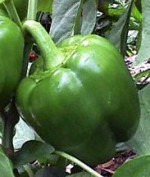 Bell peppers are produced on stiff compact attractive plants that can be grown in small gardens and containers. Most start out green but some may change color to yellow, orange, red or purplish brown when they ripen. They are sweetest when ripe but are tasty at all stages. Bell peppers are warm weather vegetables but can be grown in almost all areas of the country except at high elevations and in the extreme north. An abundance of bell peppers is a wonderful windfall as they require no blanching or special treatment to freeze.
Bell peppers are produced on stiff compact attractive plants that can be grown in small gardens and containers. Most start out green but some may change color to yellow, orange, red or purplish brown when they ripen. They are sweetest when ripe but are tasty at all stages. Bell peppers are warm weather vegetables but can be grown in almost all areas of the country except at high elevations and in the extreme north. An abundance of bell peppers is a wonderful windfall as they require no blanching or special treatment to freeze.
Here are some suggestions for growing bell peppers:
 Choose a variety based on color, days to maturation, use, and disease resistance. See my post on selecting peppers.
Choose a variety based on color, days to maturation, use, and disease resistance. See my post on selecting peppers.
 Start peppers indoors 6-8 weeks before the soil becomes warm or buy seedlings. They are exacting in their requirements for light, water, and temperature so I play it safe and buy seedlings. Sweet peppers are actually perennials so if you live in a frost free area or grow them in pots you can grow them year around.
Start peppers indoors 6-8 weeks before the soil becomes warm or buy seedlings. They are exacting in their requirements for light, water, and temperature so I play it safe and buy seedlings. Sweet peppers are actually perennials so if you live in a frost free area or grow them in pots you can grow them year around.
 Plant the seedlings in the garden when the soil temperature is 60o F or above making sure that they are hardened off.
Plant the seedlings in the garden when the soil temperature is 60o F or above making sure that they are hardened off.
 Remove flowers or fruits if the plants have less than 4-6 leaves so they will develop a good root system and plenty of leaves.
Remove flowers or fruits if the plants have less than 4-6 leaves so they will develop a good root system and plenty of leaves.
 Mulch with straw or hay in warm climates to keep the roots cool.
Mulch with straw or hay in warm climates to keep the roots cool.
 Fertilize with 5-10-10 or similar when you set out the seedlings and again around the drip line 30-45 days later. Avoid high nitrogen fertilizer as it will cause excessive growth and poor blossom set.
Fertilize with 5-10-10 or similar when you set out the seedlings and again around the drip line 30-45 days later. Avoid high nitrogen fertilizer as it will cause excessive growth and poor blossom set.
 Spray each plant with a mixture of 1 tablespoon of Epsom salts in a gallon of water at flowering to give them a shot of magnesium.
Spray each plant with a mixture of 1 tablespoon of Epsom salts in a gallon of water at flowering to give them a shot of magnesium.
 Water deeply once or twice a week. If sweet peppers dry out fruit formation may be inhibited.
Water deeply once or twice a week. If sweet peppers dry out fruit formation may be inhibited.
 Look for bugs; most bugs do not harm peppers but aphids can transmit viruses from plant to plant. If a plant develops mottled leaves, get rid of it; it has mosaic and can’t be saved, but could serve as a source of the virus that spreads the disease.
Look for bugs; most bugs do not harm peppers but aphids can transmit viruses from plant to plant. If a plant develops mottled leaves, get rid of it; it has mosaic and can’t be saved, but could serve as a source of the virus that spreads the disease.
 Harvest peppers whenever you need them. They are delicious at any size, although sweetest at maturation.
Harvest peppers whenever you need them. They are delicious at any size, although sweetest at maturation.
 If you want to grow sweet peppers in containers, provide ¾ to 1 cubic foot of soil per plant.
If you want to grow sweet peppers in containers, provide ¾ to 1 cubic foot of soil per plant.
Four plants will give a family a lot of peppers over a long period of time. If you can’t use all that are produced be sure to remove ripe peppers from the bush as leaving them there signals the bush to stop producing fruit. Any extra sweet peppers you grow can be sliced or cut into pieces, frozen on a cookie sheet, and then packed away in the freezer in plastic bags. I fill sandwich bags with stripes and each bag provides me with about a recipe’s worth of sweet pepper. I can leave them in long stripes, or dice the stripes as they defrost. Very easy!
